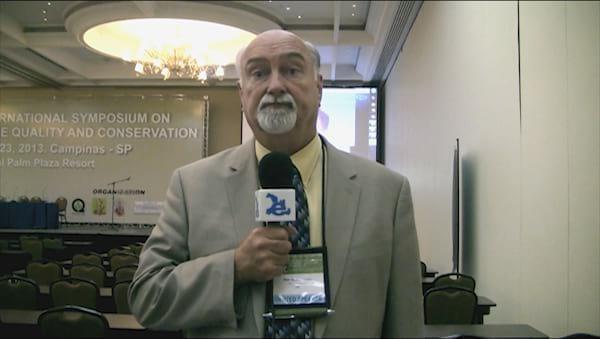Beyond the science: what the farmer looks for in the production of silage
Most silage in Ireland and the UK is harvested by contractor using selfpropelled precision-chop forage harvesters and ensiled in bunk silos. Recently the use of big bales as a method of storage has increased in popularity, now accounting for approximately 30-35% of all silages ensiled in Ireland and the UK.
The lower prices farmers receive in the European Union for milk and beef due to recent changes in the Common Agricultural Policy clearly illustrate the need to reduce costs and produce animal products as cheaply as possible. In the production of silage, the producer aims for a product with the required intake and digestibility characteristics to support levels of performance required from the class of livestock given the forage. The aims of this paper are to highlight what the farmer requires from silage production and also to present recent research data on the prediction of silage intake.
Variation in silage quality
The quality of silage produced on-farm varies dramatically both within and between years due mainly to differences in composition of material harvested, sward type, harvest date, regrowth interval, ensiling management and additive treatment. The chemical composition and feeding value of silages from all over Ireland analysed by the Hillsborough Feeding Information System since September 1999 are presented in Table 1. Silage composition is extremely variable. Dry matter (DM) concentrations range from 12.5 to 43%, ammonia nitrogen (N) concentrations vary from less than 7 to 29% of total nitrogen and predicted silage intakes for a 500 kg steer vary from 5.3 to 11.4 kg/day DM. Dry matter digestibility values range from 54 to 83%. Silages with low digestibility are also characterised by low intake potential.
Many of these silages would not even support maintenance of lactating dairy cows or finishing beef cattle while the best silages, offered as the sole diet, would sustain 23 litres of milk per cow per day or 1.1 kg liveweight gain in finishing beef cattle. The data presented in Table 1 clearly indicate the importance of producing high quality grass silage to support high levels of animal performance.
Table 1. Chemical analysis of silages ensiled in 1999.*
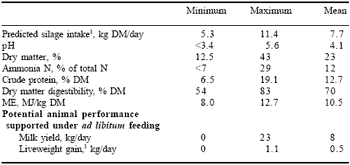
*Hillsborough, 1999.
1for a 500 kg steer.
SILAGE FEED VALUE
To accurately supplement beef and dairy cattle with the level of concentrates needed to obtain optimal animal performance from silage-based diets, it is essential to know both the nutritive value and intake potential of the forage component of the diet. The nutritive value of silage is determined primarily by digestibility.
Silage digestibility: its importance
Digestibility is the most important factor influencing feeding value and consequently performance of animals offered silage-based diets. The effects of digestibility on animal performance have been well documented. Gordon (1989c) concluded that a 10 g/kg increase in digestible organic matter in silage DM (D-value) resulted in increases in silage DM intake and milk yield of lactating dairy cattle of 0.16 and 0.37 kg/cow/day, respectively.
Similarly milk protein, which is an important component in milk pricing schemes in many countries, is influenced by silage digestibility. Keady and Mayne (1998) concluded from a review of studies undertaken at the Agricultural Research Institute of Northern Ireland that milk protein content is increased by 0.16 g/kg for each 10 g/kg increase in silage D-value. The performance of beef cattle is also highly influenced by silage digestibility. Steen (1987) concluded that a 10 g/kg increase in D-value resulted in an increase in carcass gain of beef cattle of 33 g/day when silage was offered as the entire diet and by 28 g/day when concentrates constituted proportionally 0.20 to 0.37 of total DM intake.
Digestibility is one of the major factors affecting silage intake. Steen et al. (1998) concluded from a major study in which 136 silages were offered to beef cattle, that each 10 g/kg increase in silage D-value resulted in an increase in intake of 1.5%.
MAJOR FACTORS AFFECTING DIGESTIBILITY OF SILAGE
Date of harvest
Date of harvest is the most important factor affecting digestibility. Digestibility of herbage harvested between 10 May and 7 June declines linearly by 3.6 percentage units each week harvest is delayed (Keady et al., 2000). Similarly, the rate of decline in herbage digestibility from the primary regrowth is similar to that of the primary growth. For example, Gordon (1980) and Keady et al. (1999) reported declines in D-value of 3.4 and 3.5 percentage units D-value per week delay in harvesting the primary regrowth between weeks 5 and 10 of growth. Consequently, for each week delay in harvesting grass silage to sustain milk yield or carcass gain, 1.5 and 1.2 kg additional concentrate must be fed daily to lactating dairy and finishing beef cattle, respectively.
Crop lodging
Lodging or flattening of the grass crop before harvest accelerates the rate of decline in grass digestibility. In severely lodged crops digestibility may decline by as much as nine percentage units per week (O’Kiely et al., 1987).
Sward type
Normally silage produced from old permanent pastures has a lower digestibility than silage produced from perennial ryegrass swards. Also, it is generally assumed that the optimum time to harvest grass is when the sward reaches 50% ear emergence. However, recent studies (Steen, 1992) indicate that in order to obtain silages with similar digestibility from early and late heading varieties of perennial ryegrass, they must be harvested within 7-8 days of each other even though differences in growth stages would be 24 days (Table 2). Delaying harvest until the late varieties reach 50% ear emergence would result in a reduction in D-value of 8 percentage units relative to the early heading varieties, consequently reducing silage intake and animal performance as measured by carcass gain from 0.63 to 0.40 kg/ day.
Table 2. Effect of grass variety heading date and harvest date on animal performance.*

*Steen, 1992.
Silage fermentation
Relative to well-preserved silages, poorly preserved silages with low lactic acid and high ammonia nitrogen contents normally have lower digestibility. The decline in digestibility due to deterioration in silage fermentation may be as high as 5 to 6 units of D-value.
Nitrogen fertiliser application
Increasing nitrogen fertiliser application alters silage digestibility. Keady et al. (2000) reported a decrease in silage D-value from 71.8 to 70.5% when nitrogen fertiliser application was increased from 72 to 168 kg/ha N for first-cut silage.
Prediction of silage intake
In the past thirty years many studies (Wilkins et al., 1978; Rook and Gill, 1990) have been undertaken to determine the factors influencing silage intake. The initial studies produced multi-factor relationships to predict intake. However, the accuracy of these relationships was limited due to the fact that they were based on data obtained from a number of studies and were confounded by factors such as breed of animal, previous nutritional history, physiological state, length of feeding period, concentrate feed level and composition. More recently, a major study (Steen et al., 1998) was undertaken at our institute to determine the factors affecting silage intake when offered to beef cattle. One hundred and thirty-six silages were selected to be representative of the broad range of silages produced annually across Northern Ireland.
These silages were purchased from commercial farms in Northern Ireland and had been produced from different sward types using different management strategies at ensiling and a range of additive treatments. The 136 silages were offered as the entire diet to 192 steers (initial live weight 415 kg) in a partially balanced changeover design experiment. The changeover design enabled the variations in intake due to animal effects to be removed statistically. During the feeding study detailed measurements of intake, chemical composition, in vivo digestibility and use of near infrared reflectance spectroscopy (NIRS) and electrometric titration were undertaken.
The chemical composition of the silages varied dramatically. For example, the concentrations of dry matter varied from 155 to 413 g/kg, ammonia nitrogen from 45 to 385 g/kg total N, dry matter digestibility from 53 to 80% and silage intake when offered as the sole feed from 4.3 to 10.9 kg/day DM.
Relationships between individual silage constituents and silage intake have been developed (Table 3) to provide an overview of the extent to which intake is related to, or determined by, concentrations of different silage chemical constituents. The results of this analysis clearly indicated that intake was poorly related to some chemical factors such as pH, buffering capacity and lactic, acetic and butyric acids, which previously were considered to have a major effect on silage intake. Factors of moderate importance included dry matter and ammonia nitrogen concentrations. Silage intake increased by 13 g DM for each 10 g/kg increase in silage DM content. The key factors influencing silage intake were the protein and fibre fractions and the rate and extent of digestion of these components. There were quadratic relationships between silage intake and many of the protein fractions.
For example, as silage crude protein content increased from 80 to 130 g/kg DM, silage intake increased. However when silage crude protein content increased from 140 to 160 g/kg DM, silage intake remained static while silage intake tended to decrease as silage crude protein concentration increased above 160 g/kg DM. The positive linear relationship between silage digestibility and intake identified in the present study clearly indicated an increase in silage intake of 15 g DM per 10 g/kg DM increase in silage digestibility.
One of the most interesting outcomes of this major study was the fact that NIRS, on both dried and fresh samples, provided the most accurate prediction of silage intake (R2 = 0.90) (Park et al., 1997). Subsequently a silage intake prediction system was developed using NIRS. The standard error of prediction is 7.6% of the mean intake of the 136 silages offered in the study, which is more accurate than using multi-factor relationships developed using wet chemistry.
Thirteen of the 136 silages described above were also offered to dairy cows in late lactation in order to develop a relationship between intakes of silage when offered as the sole feed to both beef and dairy cattle. Feeding models have been developed at Hillsborough for beef, dairy cattle and for sheep that use the predicted silage intakes to calculate total metabolisable energy intakes and predict performance for different inputs of concentrates.
Table 3. Relationships between individual silage parameters and silage intake.
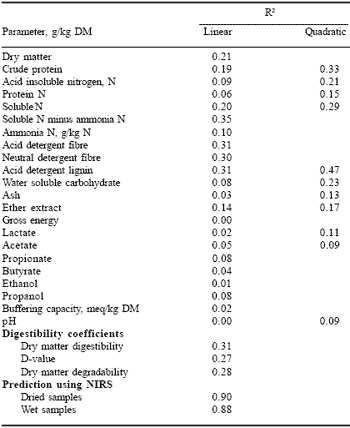
Steen et al., 1998.
Currently a Silage Feeding Information System, which provides a comprehensive silage analysis and the potential animal performance that can be achieved from the silage supplemented with different levels of concentrates, is available commercially at Hillsborough using NIRS.
PREDICTION OF SILAGE FEEDING VALUE FROM ANALYSIS OF THE HERBAGE PRIOR TO ENSILING
Recent developments in feed characterisation of grass silage (Park et al., 1997; Steen et al., 1998) have facilitated considerable improvements in prediction of silage feeding value. However, this information would be of considerably greater value in practice if predictions of silage value could be determined from analysis of herbage prior to ensiling.
A study has just been completed at Hillsborough (Keady et al., 2000) where grass from a total of 75 treatments was ensiled in 225 small scale silos from swards that had received different management practices prior to and at ensiling. The swards had received 72, 96, 120, 144 or 168 kg N/ha and were harvested either on 10, 17, 24 or 31 May or 7 June. The herbage was ensiled either untreated, treated with formic acid at 3 ml/kg or treated with an inoculant at 3 ml/kg. Following a 176 day fermentation period the silos were opened and sampled for chemical analysis and the prediction of digestible organic matter in the DM and potential dry matter intake using NIRS as described by Park et al. (1997). There were large variations in the chemical composition of the herbage and in the subsequent silages. Relationships between the chemical composition of the herbage at ensiling for each additive treatment and the feeding value, i.e. intake potential, D-value and potential ME intake, have been developed to provide an overview of the extent to which intake is related to, or determined by, the chemical composition of the herbage at ensiling. The effects of herbage composition on potential ME intake of untreated (U), formic acid (F) and inoculant (I) treated silages are presented in equations 1, 2 and 3:
| MEI for U = | 78.6 – 0.0042 (yield) – 0.076 (NDF) + 0.349 (DM) + 2.596 (PN)– 0.0221 (nitrate) | (R2 = 0.94) |
| Equation 1 | ||
| MEI for F = | -4.1 + 2.557 (PN) – 0.0036 (yield) + 0.264 (DM) + 7.28 (pH) | (R2 = 0.93) |
| Equation 2 | ||
| MEI for I = | 75.2 – 0.0053 (yield) – 0.087 (Hemi) + 2.401 (PN) + 0.2715 (DM) – 0.0143 nitrate + 0.493 (EE) | (R2 = 0.94) |
| Equation 3 | ||
| where: | MEI = metabolisable energy intake (MJ/day); yield = DM yield at harvest (kg DM/ha); NDF = neutral detergent fibre (g/kg DM); DM = dry matter (g/kg); PN = protein N (g/kg DM); nitrate = mg/ kg DM; Hemi = hemicellulose (g/kg DM); EE = ether extract (g/ kg DM); pH = pH of grass at ensiling. |
Other than digestibility, which was inversely related to herbage yield, the chemical parameters of the parent herbage which were most strongly correlated with silage intake were not the major silage parameters as identified by Steen et al. (1998).
Costs of silage production Many individuals and commercial organisations quote the relative values of grazed grass:silage:concentrates as being 1:3:6. However in these costings grass utilisation rates and the costs of land charges, paddock layout and labour for droving the cows are not included for grazed grass. In contrast, when costing silage the expensive silos, land charge and feeding costs are included and in-silo losses are also considered. More recently Keady and Anderson (1999) and Keady (1999), using herbage yield and utilisation rates recorded at the Agricultural Research Institute of Northern Ireland, and including land, labour, contractor and fixed and variable costs concluded that the costs of grazed grass, silage from a three-cut silage system and concentrates are £74, £92 and £153 per tonne of dry matter as fed to the animals. Consequently the relative costs of grazed grass, silage and concentrates are closer to 1:1.3:2.0 and not the 1:3:6 as often quoted. When costed on a metabolisable energy basis the relative value of grazed grass:silage: concentrates is 1:1.3:1.8. These costings clearly illustrate that the costs of grass production are relatively similar whether it is ensiled or grazed in situ.
MAJOR FACTORS AFFECTING THE COSTS OF SILAGE PRODUCTION
Yield
The major management factors affecting herbage yield in silage production are the level of nitrogen application and harvest date. When harvest date is delayed, herbage yield increases but digestibility declines as harvest date is one of the most important factors affecting digestibility. Keady and O’Kiely (1998) and Keady et al. (2000) concluded that herbage yield of the primary growth increased by 135 and 151 kg DM per day delay in harvest while digestibility declined by 3.9 and 4.2 g/kg per day delay in harvest, respectively.
Consequently, delaying the first harvest by one week increases yield by approximately 1 tonne DM/ha and decreases silage costs (assuming a land charge) by £11/tonne utilisable DM to £74 for silage from the first cut, but at a cost of reducing digestibility and ME by 0.5 MJ/kg DM. Digestibility is the most important factor affecting animal performance from grass silage.
As outlined earlier, to produce a similar milk yield from grass harvested one week later than intended, an additional 1.5 kg concentrates per cow per day would be required. Consequently, savings on silage cost could be eroded by the additional level of concentrates required to maintain animal performance.
Keady et al. (2000) concluded that as nitrogen application increased from 72 to 168 kg/ha N for first cut silage, herbage yield increased by 7.8 kg DM/kg N on average. Meanwhile Keady and O’Kiely (1998) concluded that herbage yield increased by 5.2 kg DM/kg N when nitrogen fertilisation rate increased from 120 to 168 kg DM/ha for first cut silage. However care must be taken not to apply excessive nitrogen fertiliser otherwise the feeding value of the silage will be reduced.
There has been renewed interest in pre-wilting of grass prior to ensiling, given the development of sophisticated conditioning and tedding equipment and the desire to reduce effluent output from an environmental point of view. Detailed studies undertaken at this institute (Wright, 1997) examining factors affecting the speed of wilting indicate that the most important weather factor is the duration and intensity of sunshine and the most important management factor is the density of the swath, i.e. the lower the density the greater the drying rate. In a three-cut system, wilting does not alter the cost of silage production even though wilting increases machinery costs due to tedding and rowing up prior to harvest, but reduces silo costs and additive costs.
A total of eleven recent studies have been undertaken at this Institute (Patterson et al., 1996; 1998) to evaluate the effects of rapid wilting of herbage on subsequent dairy cow performance (Table 4). These studies indicate that when herbage dry matter was increased from 160 to 320 g/kg at ensiling, rapid wilting dramatically increased intake by 17% and slightly improved milk yield by 2.4% and the concentrations of fat and protein.
However rapid wilting reduces output of utilised silage/ha. In a three-cut system, wilting increased the value of milk output/cow/day but reduced cow feeding days by 174/ha of herbage ensiled and milk volume output by 3074 l/ha, consequently decreasing the value of animal product.
Table 4. The effects of wilting on animal performance.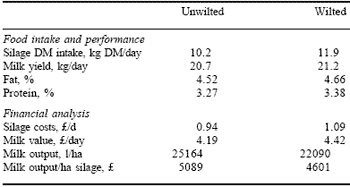
Milk price is based at 19 p/l at 4% fat and 3.18% protein. Each 0.01% change in fat and protein concentration alters milk price by 0.018 and 0.032 p/litre, respectively. (Patterson et al., 1996; 1998).
Additive treatment
Until recently, the principle objective in applying a silage additive was to improve silage fermentation under difficult ensiling conditions. This was achieved by applying either acid or sugar based additives. However, more recent research has shown that the use of effective inoculants can substantially improve animal performance without necessarily altering the fermentation quality of the silage at the time of feeding.
Animal performance is the most important measure of the efficacy of a silage additive, as producers are paid for animal product and not for the preservation quality of silages as measured by conventional laboratory analysis. When applying additives it is important to apply them at the correct rate, taking account of changes in the moisture content of the grass being ensiled. For example, if the dry matter of the herbage is increased from 180 to 250 g/kg, the fresh weight of grass would be reduced from 29.5 to 21 t/ ha, consequently reducing additive requirement by 40%/ha. Silage costs are decreased by £7.5 per tonne of utilisable dry matter if an additive is not applied at ensiling. Consequently it is essential to make the correct decision when choosing an additive.
Keady (1998) reviewed the effects of silage additives on silage fermentation and animal performance. It was concluded from the mean of 11 comparisons for each additive based on either sulphuric acid, molasses or enzymes as the main active ingredient that these additives will improve silage fermentation but will not significantly improve animal performance.
Consequently, the return on investment is zero, yet the costs of silage production are increased. Therefore, use of these additives must be questioned.
Furthermore, formic acid under difficult ensiling conditions will increase animal performance; but under moderate to easy ensiling conditions formic acid will not give an economic response. Finally, Keady (1998) concluded that inoculant treatment increased animal performance across a wide range of conditions, regardless of whether the untreated silage was well or poorly preserved. From the mean of 11 studies undertaken at Hillsborough, inoculant treatment increased fat and protein corrected milk yield by 1.3 l/cow/ day, consequently increasing milk value by 25 p/cow/day, assuming a milk price of 19 p/l. In these studies some products did not alter animal performance whereas others had major beneficial effects. The effects of an inoculant based on a single strain of Lactobacillus plantarum which supplied 1 million CFU/g of grass at ensiling are presented in Table 5 (adopted from the studies of Gordon (1989a; 1989b) and Mayne (1990)). The use of that particular inoculant increased milk output resulting in a return on investment of 2:1. These costings do not take into account any reduction in in-silo losses due to inoculant treatment.
Within the industry there is a popular misconception that inoculant treatment will not improve animal performance under conditions in which untreated silage would be poorly preserved. Keady (1998) concluded from a review of nine comparisons in which the untreated silages were poorly preserved, that inoculant treatment increased performance of beef and dairy cattle. More recently Patterson (1999, unpublished data) evaluated three inoculant-based products under difficult ensiling conditions (Table 6). Even though treatment with the inoculant did not improve fermentation, inoculant treatment increased animal performance, improving milk yield by 1.5 kg/day and milk protein content by 0.05%. The many studies undertaken in the dairy and beef herds at Hillsborough clearly indicate that an effective inoculant will result in similar improvements in animal performance under a wide range of ensiling conditions, whether the herbage is ensiled direct cut or wilted prior to ensiling.
Table 5. The effects of an inoculant based on L. plantarum on animal performance from the mean of three studies.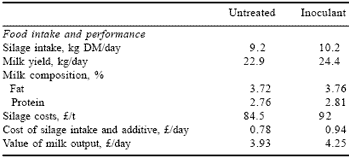
Milk price is based at 19 p/l at 4% fat and 3.18% protein. Each 0.01% change in fat and protein concentration alters milk price by 0.018 and 0.032 p/litre, respectively. (Gordon, 1989a; 1989b; Mayne, 1990).
Table 6. The effects of inoculant treatment under difficult ensiling conditions on animal performance - three comparisons.*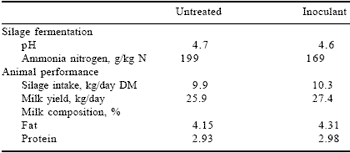
*Patterson, 1999 unpublished data.
Harvest costs
Altering harvesting charges by £25/harvest/ha changes silage costs by £7.55/t utilisable DM in the three-cut system.
Silo costs
On many farms it could be assumed that the cost of silo construction has been fully written off. Consequently, if silage storage costs are omitted, the cost of utilised forage from a three-cut silage system would be reduced to £86/t assuming a land charge.
Big bales
If silage is ensiled in big bales, assuming a mean dry matter content of 25%, silage DM losses of 12% and the provision of a concrete base for storage, silage costs are increased by £4/t DM relative to clamp silage in a three-cut silage system. However if only the light crops of the second and third harvest are ensiled, the cost differential between big bale and clamp silage diminishes. This assumes no loss of bales due to damage by vermin.
Conclusions
Grass silage is, and will remain, the basal forage for dairy and beef cattle during the indoor feeding period in many areas in Northwestern Europe and elsewhere. The costs of silage production are relatively similar to those of grazing animals at pasture with the relative value of grass:silage:concentrate being 1:1.3:2.0, and not 1:3:6 as often quoted. Digestibility is the most important factor affecting animal performance in silage production. Silage intake is highly correlated to the protein and fibre fractions and not silage fermentation characteristics. Silage feeding value can be predicted from the chemical composition of the herbage at ensiling. The use of a well-proven effective inoculant results in an economic return of £2 for every pound invested.
References
Gordon, F.J. 1980. The effects of interval between harvest and wilting on silage for milk production. Animal Production 31:35-41.
Gordon, F.J. 1989a. An evaluation through lactating dairy cattle of a bacterial inoculant as an additive for grass silage. Grass and Forage Science 44:169-179.
Gordon, F.J. 1989b. A further study on the evaluation through lactating cattle of a bacterial inoculant as an additive for grass silage. Grass and Forage Science 44:353-367.
Gordon, F.J. 1989c. The principles of making and storing high quality, high intake silage. In: Silage for milk production (C.S. Mayne, ed.). Occasional Symposium of the British Grassland Society No. 23, pp. 3-41.
Keady, T.W.J. 1998. The production of high feed value grass silage and the choice of compound feed type to maximise animal performance. In: Biotechnology in the Feed Industry, Proceedings of Alltech’s 14th Annual Symposium (T.P. Lyons and K.A. Jacques, eds.), pp. 157-180.
Keady, T.W.J. 1999. High feed value grass silage. How, why and its relative value to grazed grass. Paper presented at the Irish Grain and Feed Association Annual Conference, November 10, Dublin.
Keady, T.W.J. and D. Anderson. 1999. Good grazed grass is not free. Irish Farmers Journal, Vol. 51, No. 23, June 5, pp. 22-23.
Keady, T.W.J. and C.S. Mayne. 1998. Improving milk composition during the winter period through feeding. Applied Research and Development Council (NI), Technical Publication No. 1.
Keady, T.W.J. and P. O’Kiely. 1998. An evaluation of potassium and nitrogen fertilisation of grassland, and date of harvest, on fermentation, effluent production, dry matter recovery and predicted feeding value of silage. Grass and Forage Science 53:326-337.
Keady, T.W.J., C.S. Mayne, D.A. Fitzpatrick and M. Marsden. 1999. The effects of energy source and level of digestible undegradable protein in concentrates on silage intake and performance of lactating dairy cows offered a range of grass silages. Animal Science 68:763-778.
Keady, T.W.J., C.S. Mayne and D.A. Fitzpatrick. 2000. Prediction of silage feeding value from the analysis of the herbage at ensiling and effects of nitrogen fertiliser, date of harvest and additive treatment on grass silage composition. Journal of Agricultural Science, Cambridge (In press).
Mayne, C.S. 1990. An evaluation of an inoculant of Lactobacillus plantarum as an additive for grass silage for dairy cattle. Animal Production 51:1-13.
O’Kiely, P., A.V. Flynn and R. Wilson. 1987. New concepts in silage making. Irish Grassland and Animal Production Association Journal 21:38-50.
Park, R.S., F.J. Gordon, R.E. Agnew, R.J. Barnes and R.W.J. Steen. 1997. The use of near infrared reflectance spectroscopy on dried samples to predict biological parameters of grass silage. Animal Feed Science and Technology 68:235-246.
Patterson, D.C., T. Yan and F.J. Gordon. 1996. The effects of wilting of grass prior to ensiling on the response to bacterial inoculation. 2. Intake and performance by dairy cattle over three harvests. Animal Science 62:413-430.
Patterson, D.C., T. Yan and F.J. Gordon. 1998. The effects of bacterial inoculation of unwilted and wilted grass silages. 2. Intake, performance and eating behaviour by dairy cattle over eight harvests. Journal of Agricultural Science 131:113-119.
Rook, A.J. and M. Gill. 1990. Prediction of the voluntary intake of grass silages by beef cattle. 1. Linear regression analysis. Animal Production 50:425-438.
Steen, R.W.J. 1987. Factors affecting the utilisation of grass silage for beef production. In: Efficient beef production from grass (J. Frame, ed.). Occasional Symposium of the British Grassland Society No. 22, pp. 129- 139.
Author: TIM W. J. KEADY
Agricultural Research Institute of Northern Ireland, Hillsborough, Co. Down, Northern Ireland





